By Alex Trukan
Red Bull Leipzig has been a revelation of this Bundesliga season, currently sitting second, just three points behind Bayern Munich. Not only results but also their style of play is what they became famous for. RB Leipzig is mainly recognised as high intensity, aggressive pressing side which tries to win the ball back high up the pitch, as soon as it is possible. This pressing tactics can’t be, however sustained at all times, throughout the whole game. From a physical point of view, players should have active rest interval periods of a lower intensity. Also from a tactical perspective, it is beneficial to alter strategies to keep the play unpredictable. When high pressing is not applied and the team is defending when organised, they employ a successful 4-4-2 defensive block. Very simple, with basic movements and shapes, however, much more difficult to play through. This article will explore some of the ways to beat this block, using the example of one of the friendly games against Ajax Amsterdam.
When both teams are organised and no quick counter attacking options are available, an attacking team might try to establish possession. Usually the starting point is the back four where the ball is circulated. This slows the game down and gives the feel for the opposition shape. It also helps to create potential gaps in 4-4-2 block and play around first strikers unit. After a quick switch of play, two strikers won’t be usually quick enough to come across and screen forward passes. This might be a trigger to get the ball forwards. Player on the ‘outside’ of the opposition’s strikers unit should take a first touch forwards with his back foot.
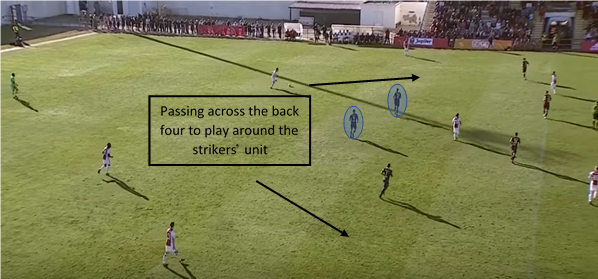
However, it is important to remember, that opposition will work off triggers and try to apply high press as well. One of the triggers might be a ball to full backs. To avoid this, full back should make a quick decision whether to go forwards beyond the strikers’ unit (so they can’t press). If this is not possible, then the ball should be played sideways quickly so the strikers don’t have a chance to cut the options down. Usually, if the team manages to play away from pressing and get the ball to the opposite side centre back or full back, they will be able to drive in and play forwards breaking the first opposition unit. So, in a way, it can be beneficial to ‘tease’ the opposition and wait until they press and commit players before playing forwards.
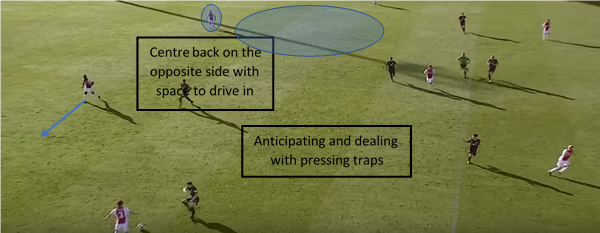
Opposition units can be also beat by playing not around them but through them. Centre backs should practice an ability to pass the ball on the ground straight into strikers and other players positioned behind opposition’s midfield unit. Defensive midfielder would be then looking to support from behind and offer an option for a wall pass. This kind of a pass from a centre back is also a trigger for players to start making runs in behind the back line to penetrate quickly.
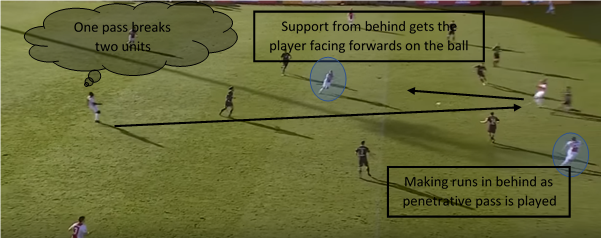
This is linked to different types of movements players in front of the ball can make. One of it is a combined movement of a striker and full back. Striker would be looking to come towards the ball, what will hopefully push up the back line. At the same time, one of the full backs, would start a run in behind from a second line. This gives two main options for a centre back – play to the striker who can then combine play with midfielders, or play directly into full back to go in behind. Striker coming deeper can be especially useful against flat 4-4-2 as spaces between units might be available with no defensive midfielder around.
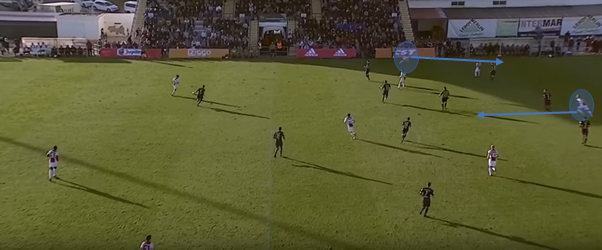
If full back decides to stay in the middle third, and the ball is played into him, one of the strikers should make a run to support him. This will allow full back to play around the corner and then sprint on the overlap. This quick way of breaking a defensive block is especially effective after a switch of play. Compactness of 4-4-2 units as the come across might isolate opposition full back or wide midfielder.
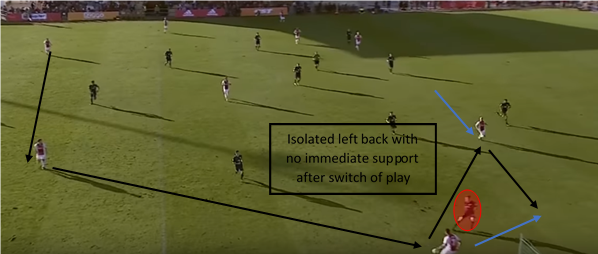
Starting runs in behind from half spaces might be another effective strategy against flat 4-4-2. As there is opposition playing in flat units, making a run from in between midfielders and defenders might create a problem which player will follow a runner. This can be made by midfielders as well as striker who has previously come deeper into own half.
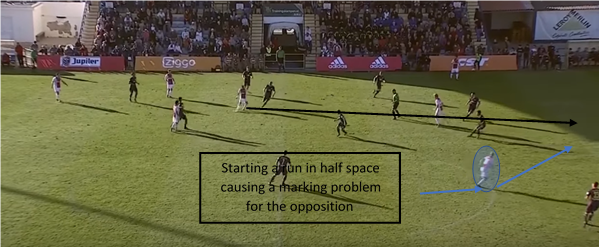
Finally, the tempo at which an attack is made against 4-4-2 block should be considered. The teams are often encouraged to play quickly and off one and two touches. This brings many advantages, however, even if the tempo is quick, but there is no variation in it, the play becomes more predictable. It also helps the defending team to get into a good ‘flow’ as quick pace at which the ball moves keeps them concentrated. This is why, the ball should be sometimes slowed down and the possession might be kept by one player for longer. Change of tempo might help with ‘teasing’ the opposition and making them commit to then play around and through them quickly.
By Alex Trukan, Development Coach, Nottingham Forest
@AlexTrukan


